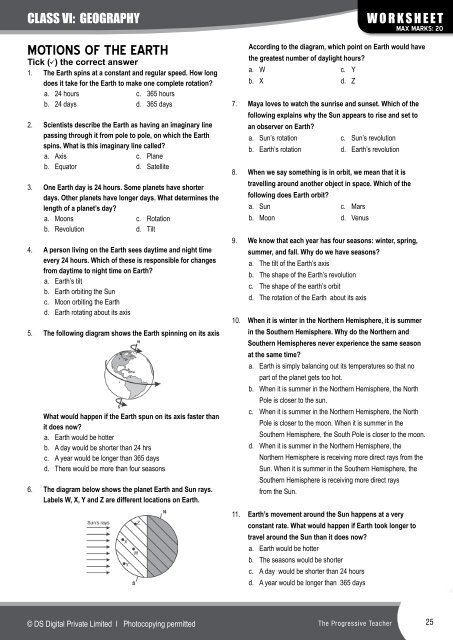The Progressive Teacher Vol 04 Issue 03
This issue of The Progressive Teacher focuses on "New Trends in Education ". In this edition, articles explore contemporary trends to enhance interactive learning amongst students.
This issue of The Progressive Teacher focuses on "New Trends in Education ". In this edition, articles explore contemporary trends to enhance interactive learning amongst students.
You also want an ePaper? Increase the reach of your titles
YUMPU automatically turns print PDFs into web optimized ePapers that Google loves.
Class VI: geography<br />
Motions of the Earth<br />
Tick ( ) the correct answer<br />
1. <strong>The</strong> Earth spins at a constant and regular speed. How long<br />
does it take for the Earth to make one complete rotation?<br />
a. 24 hours c. 365 hours<br />
b. 24 days d. 365 days<br />
2. Scientists describe the Earth as having an imaginary line<br />
passing through it from pole to pole, on which the Earth<br />
spins. What is this imaginary line called?<br />
a. Axis c. Plane<br />
b. Equator d. Satellite<br />
3. One Earth day is 24 hours. Some planets have shorter<br />
days. Other planets have longer days. What determines the<br />
length of a planet’s day?<br />
a. Moons c. Rotation<br />
b. Revolution d. Tilt<br />
4. A person living on the Earth sees daytime and night time<br />
every 24 hours. Which of these is responsible for changes<br />
from daytime to night time on Earth?<br />
a. Earth’s tilt<br />
b. Earth orbiting the Sun<br />
c. Moon orbiting the Earth<br />
d. Earth rotating about its axis<br />
5. <strong>The</strong> following diagram shows the Earth spinning on its axis<br />
What would happen if the Earth spun on its axis faster than<br />
it does now?<br />
a. Earth would be hotter<br />
b. A day would be shorter than 24 hrs<br />
c. A year would be longer than 365 days<br />
d. <strong>The</strong>re would be more than four seasons<br />
6. <strong>The</strong> diagram below shows the planet Earth and Sun rays.<br />
Labels W, X, Y and Z are different locations on Earth.<br />
worksheet<br />
Max Marks: 20<br />
According to the diagram, which point on Earth would have<br />
the greatest number of daylight hours?<br />
a. W c. Y<br />
b. X d. Z<br />
7. Maya loves to watch the sunrise and sunset. Which of the<br />
following explains why the Sun appears to rise and set to<br />
an observer on Earth?<br />
a. Sun’s rotation c. Sun’s revolution<br />
b. Earth’s rotation d. Earth’s revolution<br />
8. When we say something is in orbit, we mean that it is<br />
travelling around another object in space. Which of the<br />
following does Earth orbit?<br />
a. Sun c. Mars<br />
b. Moon d. Venus<br />
9. We know that each year has four seasons: winter, spring,<br />
summer, and fall. Why do we have seasons?<br />
a. <strong>The</strong> tilt of the Earth’s axis<br />
b. <strong>The</strong> shape of the Earth’s revolution<br />
c. <strong>The</strong> shape of the earth’s orbit<br />
d. <strong>The</strong> rotation of the Earth about its axis<br />
10. When it is winter in the Northern Hemisphere, it is summer<br />
in the Southern Hemisphere. Why do the Northern and<br />
Southern Hemispheres never experience the same season<br />
at the same time?<br />
a. Earth is simply balancing out its temperatures so that no<br />
part of the planet gets too hot.<br />
b. When it is summer in the Northern Hemisphere, the North<br />
Pole is closer to the sun.<br />
c. When it is summer in the Northern Hemisphere, the North<br />
Pole is closer to the moon. When it is summer in the<br />
Southern Hemisphere, the South Pole is closer to the moon.<br />
d. When it is summer in the Northern Hemisphere, the<br />
Northern Hemisphere is receiving more direct rays from the<br />
Sun. When it is summer in the Southern Hemisphere, the<br />
Southern Hemisphere is receiving more direct rays<br />
from the Sun.<br />
11. Earth’s movement around the Sun happens at a very<br />
constant rate. What would happen if Earth took longer to<br />
travel around the Sun than it does now?<br />
a. Earth would be hotter<br />
b. <strong>The</strong> seasons would be shorter<br />
c. A day would be shorter than 24 hours<br />
d. A year would be longer than 365 days<br />
© DS Digital Private Limited I Photocopying permitted <strong>The</strong> <strong>Progressive</strong> <strong>Teacher</strong><br />
25


















